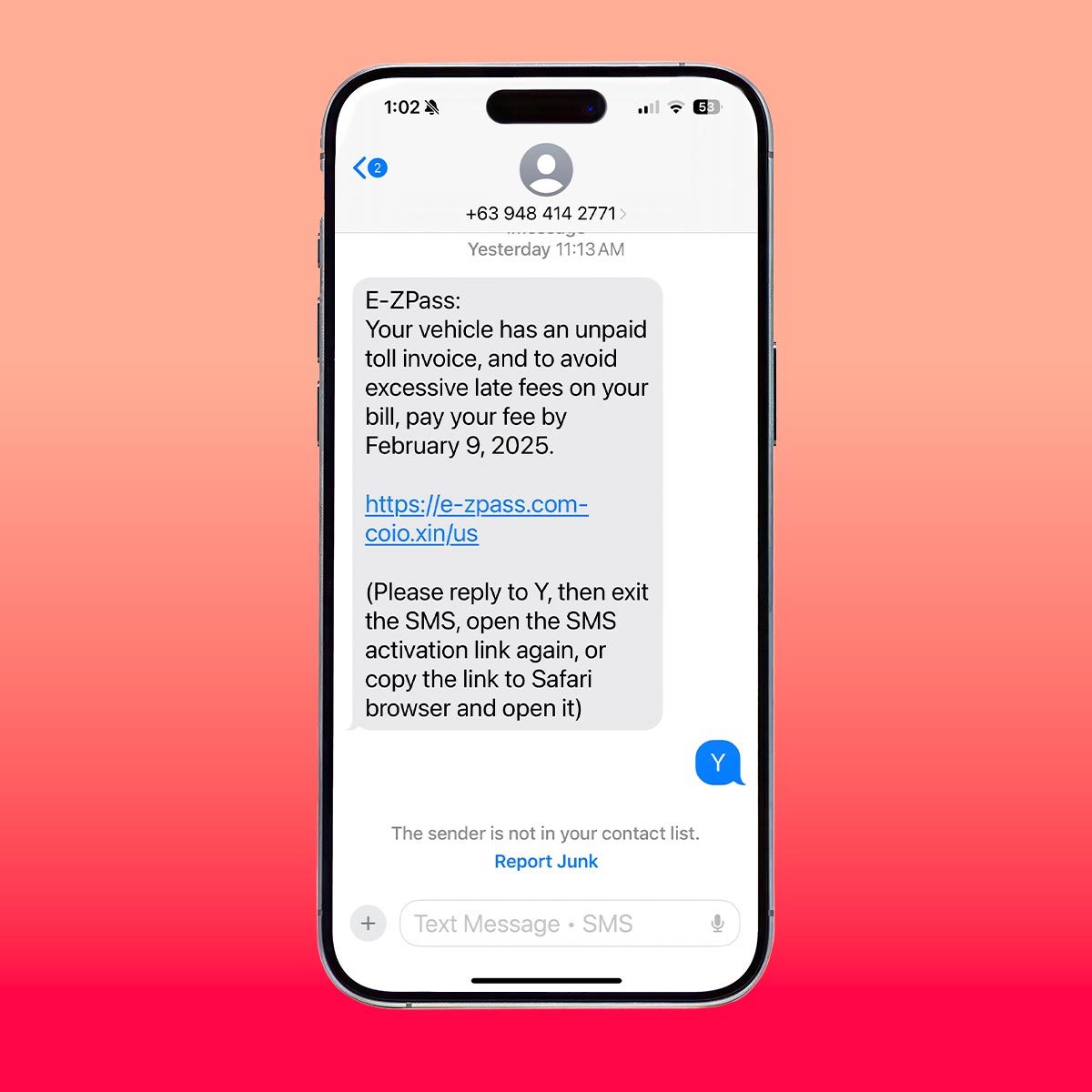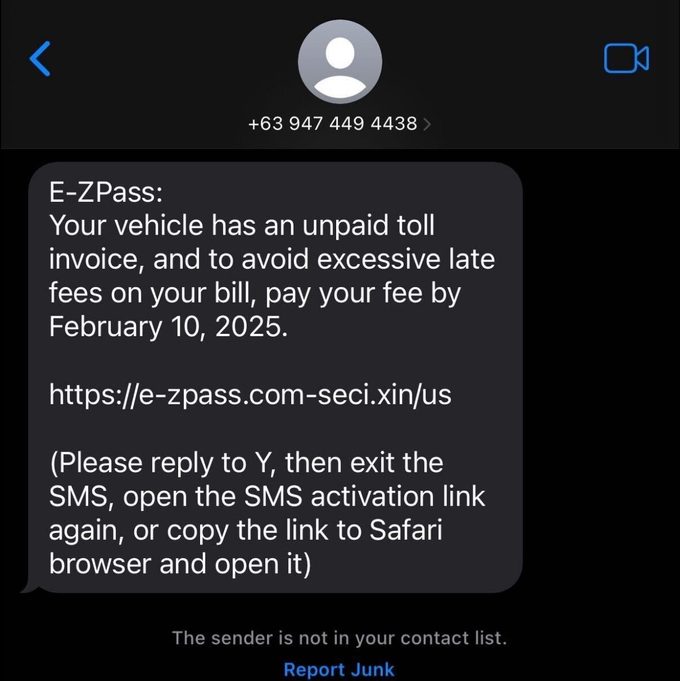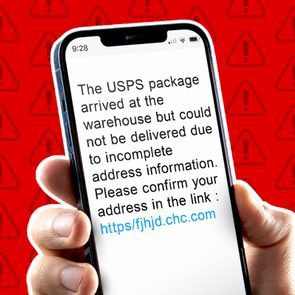Scammers are finding success with a new swindle. Here's how to protect yourself.

Scam Alert: A New E-ZPass Scam Text Is on the Rise—Here Are the Red Flags You Need to Know

The scam calls about your car’s extended warranty (you know, the one you never signed up for) seem to be finally waning. But if scammers aren’t calling, they’re texting, and their texts are usually encouraging you to act fast because of some unpaid bill or expired registration. The scammers know what they’re doing: They want to incite fear and get you to click their link, if only to double-check that you don’t owe a thing.
Case in point: the new E-ZPass scam aiming to catch you off guard and swindle you out of your savings. To learn what this scam text is and how to avoid falling prey, we talked to three cybersecurity and digital-safety experts. Ahead, we’re breaking down everything you need to know.
Get Reader’s Digest’s Read Up newsletter for more scam news, humor, travel, tech and fun facts all week long.
What is the E-ZPass scam?

The E-ZPass scam is fraudsters’ latest attempt to trick you into parting ways with your money. You may see it in your email (phishing) or as a text (smishing), but either way, this scam is not to be messed with.
The message attempts to create a sense of urgency. And the scammers tend to mention exorbitant late fees as a scare tactic.
“Typically, a link for payment is included, which, once clicked, puts you at risk of compromising sensitive information, such as your credit card, social security, bank account and whatever else the scammer can get ahold of,” says Charlie Moore, chief consumer digital safety advisor at identity-theft-prevention company Aura. “The message claims to be from the E-ZPass service center but is really a scammer trying to steal your money quickly.”
The problem with the E-ZPass scam, and all online scams, is that they aim to be familiar. “Like many scams, the message appears to be from an entity that you trust or whose legitimacy you have no reason to question,” explains Brian Cute, chief operating officer and director of the Capacity & Resilience program for the nonprofit cybersecurity organization Global Cyber Alliance.
What are the red flags of the scam?
The E-ZPass scam has some glaring red flags, and as long as you know what to look for, you should be able to stay safe. Jon Clay, vice president of threat intelligence at cybersecurity company Trend Micro, tells us what to look out for:
- Texts from unknown or suspicious numbers claiming immediate toll payment is required
- Messages containing grammatical errors or unusual phrasing
- Urgent language designed to create panic, such as threats of fines or legal action
- Links that don’t match your state’s official E-ZPass website and contain extra characters or unfamiliar domains
Pay special attention to the tone of the text. Moore says scam texts will typically include a sense of urgency or a threatening tone. “E-ZPass will never send you any kind of threatening messages about unpaid tolls via text or email,” he says. “If something feels off, it likely is.”
For that matter, E-ZPass will never send an email or contact you requesting sensitive personal information, such as credit card or social security numbers, user names, passwords or other confidential personal details. “If you receive an email or text with these requests, it’s a scammer,” Moore says.
Still stumped? Look at (but don’t click!) the URL in the text. It’s a dead giveaway. “Although scammers can use AI to create convincing messages free of errors, their domains don’t lie,” he says. “Verify the domain and service center of your local E-ZPass to make sure the communication is legitimate.”
Who has received the E-ZPass scam text so far?
So far, the E-ZPass scam (also known as an unpaid toll scam) has appeared primarily in states with E-ZPass. But it’s also been seen in North Carolina and Texas, which use different electronic toll programs, as well as in Connecticut, which has no tolls but is surrounded on three sides by states using E-ZPass.
“Cybercriminals often send mass phishing messages to random phone numbers, meaning individuals in states without E-ZPass toll systems could also receive these scam texts,” Clay says.
Moore warns that scammers are finding success with the unpaid toll scam, which means it will continue to become more widespread. “Anyone can be a target of this kind of scam,” he warns. “Look out for issued warnings from your local attorney general’s office, E-ZPass in your area and on your local broadcast stations. The FTC (Federal Trade Commission) put out a warning on toll scams in early January.”
What should you do if you receive the E-ZPass scam?
If you receive the E-ZPass scam text, don’t fret—but do follow these steps from our cybersecurity experts to protect your phone’s security.
- Don’t click on any links. “Clicking on a bad link may lead you to a phishing website where your personal information is stolen [or] the site installs malware on your device or gives the attackers remote access to your device,” Cute says.
- Don’t share sensitive information. Never give anyone your credit card or baking information.
- Don’t respond. You should never respond to unexpected text messages, but it’s especially important to avoid those that include links.
- Delete the text. E-ZPass typically sends bills in the mail or charges your account electronically via its web portal. If you get a text, it’s likely a scammer.
- Report it. Forward scam texts to 7726 (SPAM), and report them to the FTC on its fraud-reporting site. You can also select “report junk” in your messaging app to report the text to the app.
- Check your official E-ZPass account. Log in directly through the official E-ZPass website for your state to find out whether you actually owe a toll.
Will E-ZPass ever text you?

E-ZPass sends text messages to account holders only if they’ve opted to receive mobile alerts. And even then, it will send only certain information via text. “E-ZPass does not send out bills via text, so if you receive one including a link to click or something to download, immediately delete it and block the number,” Moore advises.
All three experts agree on that. “They will never demand payment through a text message or provide a link to enter sensitive information,” Clay says. “Always verify any communication by going directly to the official E-ZPass website.”
How do you know if you have an unpaid toll?
If you’re concerned about an unpaid toll, log in to your E-ZPass account (each participating state has its own E-ZPass website and login page) and check. There’s always the possibility that your credit card expired and you forgot to give E-ZPass the new information.
OK, but what if you don’t have E-ZPass but drive through the tolls in states with the electronic tolling program? Check your mail. E-ZPass will mail a bill to the address on file with your vehicle’s registration. It won’t text you.
About the experts
|
Why trust us
Reader’s Digest has published hundreds of articles on personal technology, arming readers with the knowledge to protect themselves against cybersecurity threats and internet scams as well as revealing the best tips, tricks and shortcuts for computers, cellphones, apps, texting, social media and more. For this piece, Jaime Stathis tapped her experience as a journalist who has written dozens of articles about scams and digital security for Reader’s Digest to ensure that all information is accurate and offers the best possible advice to readers. We rely on credentialed experts with personal experience and know-how as well as primary sources including tech companies, professional organizations and academic institutions. We verify all facts and data and revisit them over time to ensure they remain accurate and up to date. Read more about our team, our contributors and our editorial policies.
Sources:
- Federal Trade Commission: “Got a text about unpaid tolls? It’s probably a scam”
- Charlie Moore, chief consumer digital safety advisor at Aura; interviewed, February 2025
- Jon Clay, vice president of threat intelligence at Trend Micro and host of the TrendTalksThreat podcast; interviewed, February 2025
- Brian Cute, chief operating officer and director of the Capacity & Resilience program for Global Cyber Alliance; interviewed, February 2025























